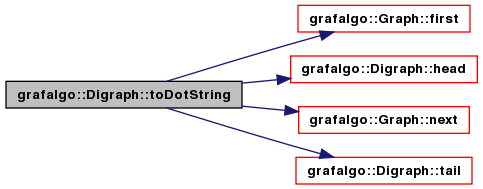|
Grafalgo
Library of useful data structures and algorithms
|
|
Grafalgo
Library of useful data structures and algorithms
|
Data structure for undirected graph with edge weights. More...
#include <Digraph.h>
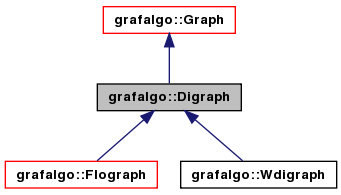
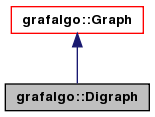
Public Member Functions | |
| Digraph (int=1, int=1) | |
| Construct a Digraph with space for a specified number of vertices and edges. | |
| void | resize (int, int) |
| Resize a Digraph object. | |
| void | resize (int numv) |
| void | expand (int, int) |
| Expand the space available for this Digraph. | |
| void | expand (int numv) |
| vertex | tail (edge) const |
| Get the tail (starting point) of a directed edge. | |
| vertex | head (edge) const |
| Get the head (starting point) of a directed edge. | |
| virtual edge | firstAt (vertex) const |
| Get the first edge incident to a vertex. | |
| virtual edge | nextAt (vertex, edge) const |
| Get the next edge incident to a specific vertex. | |
| edge | firstIn (vertex) const |
| Get the first edge incident to a vertex. | |
| edge | nextIn (vertex, edge) const |
| Get the next incoming edge incident to a specific vertex. | |
| edge | firstOut (vertex) const |
| Get the first edge leaving a specified vertex. | |
| edge | nextOut (vertex, edge) const |
| Get the next outgoing edge incident to a specific vertex. | |
| edge | joinWith (vertex, vertex, edge) |
| Join two vertices with a specific edge. | |
| bool | remove (edge) |
| Remove an edge from the Diraph. | |
| void | rgraph (int, int) |
| Read a graph. | |
| void | rdag (int, int) |
| Generate a random directed acyclic graph. | |
| virtual string & | toDotString (string &) const |
| Construct a string in dot file format representation of the Directed Graph object. | |
Protected Member Functions | |
| void | makeSpace (int, int) |
| Allocate and initialize dynamic storage for Digraph. | |
| void | freeSpace () |
| Free space used by graph. | |
| string & | adjList2string (vertex, string &) const |
| Create a string representation of an adjacency list. | |
| bool | readAdjList (istream &) |
| Read one edge from an input stream, add it to the graph. | |
Private Member Functions | |
| Digraph & | operator= (const Digraph &) |
Private Attributes | |
| edge * | fi |
| fi[u] is first in edge | |
Data structure for undirected graph with edge weights.
Digraph size (number of vertices and max number of edges) must be specified when a Digraph object is constructed. Edges can be added and removed from the graph. Methods are provided to facilitate graph traversal, either by iterating through all edges of the graph or all edges incident to a specific vertex.
| grafalgo::Digraph::Digraph | ( | int | numv = 1, |
| int | maxe = 1 |
||
| ) |
Construct a Digraph with space for a specified number of vertices and edges.
| numv | is the maximum number of vertices in the graph |
| maxe | is the maximum number of edges |
Definition at line 18 of file Digraph.cpp.

| string & grafalgo::Digraph::adjList2string | ( | vertex | u, |
| string & | s | ||
| ) | const [protected, virtual] |
Create a string representation of an adjacency list.
| u | is a vertex number |
| s | is a reference to a string in which the result is returned |
Reimplemented from grafalgo::Graph.
Reimplemented in grafalgo::Flograph, grafalgo::Mflograph, grafalgo::Wdigraph, and grafalgo::Wflograph.
Definition at line 126 of file Digraph.cpp.

| void grafalgo::Digraph::expand | ( | int | numv, |
| int | maxe | ||
| ) | [virtual] |
Expand the space available for this Digraph.
Rebuilds old value in new space.
| size | is the size of the resized object. |
Reimplemented from grafalgo::Graph.
Reimplemented in grafalgo::Flograph, grafalgo::Mflograph, grafalgo::Wdigraph, and grafalgo::Wflograph.
Definition at line 63 of file Digraph.cpp.


| edge grafalgo::Digraph::firstAt | ( | vertex | v | ) | const [inline, virtual] |
Get the first edge incident to a vertex.
| v | is the the vertex of interest |
Reimplemented from grafalgo::Graph.
Definition at line 84 of file Digraph.h.

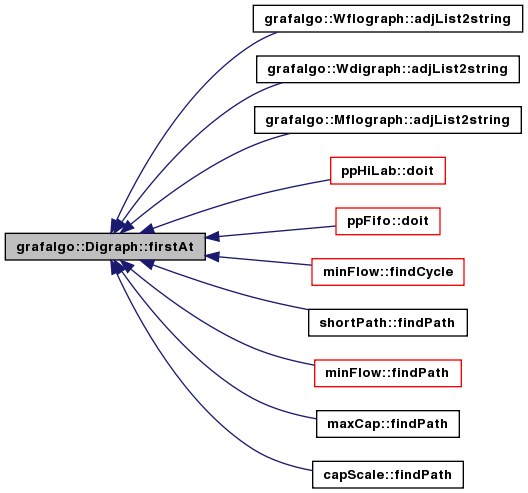
| edge grafalgo::Digraph::firstIn | ( | vertex | v | ) | const [inline] |
| edge grafalgo::Digraph::firstOut | ( | vertex | v | ) | const [inline] |
| void grafalgo::Digraph::freeSpace | ( | ) | [protected] |
Free space used by graph.
Reimplemented from grafalgo::Graph.
Reimplemented in grafalgo::Flograph, grafalgo::Mflograph, grafalgo::Wdigraph, and grafalgo::Wflograph.
Definition at line 43 of file Digraph.cpp.

| edge grafalgo::Digraph::head | ( | edge | e | ) | const [inline] |
| edge grafalgo::Digraph::joinWith | ( | vertex | u, |
| vertex | v, | ||
| edge | e | ||
| ) | [virtual] |
Join two vertices with a specific edge.
| u | is the tail of the new edge |
| v | is the head of the new edge |
| e | is the number of an idle edge |
Reimplemented from grafalgo::Graph.
Definition at line 75 of file Digraph.cpp.
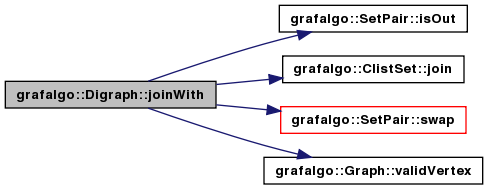
| void grafalgo::Digraph::makeSpace | ( | int | numv, |
| int | maxe | ||
| ) | [protected] |
Allocate and initialize dynamic storage for Digraph.
| numv | is the number of vertices to allocate space for |
| maxe | is the number of edges to allocate space for |
Reimplemented from grafalgo::Graph.
Reimplemented in grafalgo::Flograph, grafalgo::Mflograph, grafalgo::Wdigraph, and grafalgo::Wflograph.
Definition at line 28 of file Digraph.cpp.

| edge grafalgo::Digraph::nextAt | ( | vertex | v, |
| edge | e | ||
| ) | const [inline, virtual] |
Get the next edge incident to a specific vertex.
| v | is the edge whose adjacency list we're accessing |
| e | is the edge whose successor is requested |
Reimplemented from grafalgo::Graph.
Definition at line 95 of file Digraph.h.

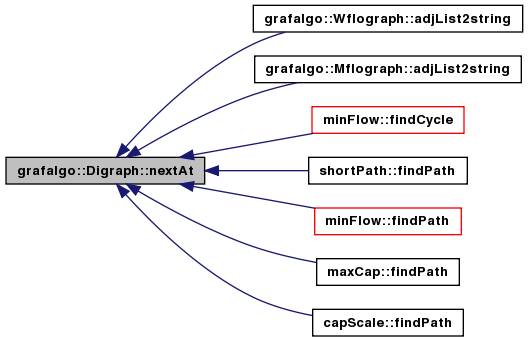
| edge grafalgo::Digraph::nextIn | ( | vertex | v, |
| edge | e | ||
| ) | const [inline] |
Get the next incoming edge incident to a specific vertex.
| v | is a vertex whose edges we're iterating through |
| e | is the edge whose successor is requested |
Definition at line 118 of file Digraph.h.

| edge grafalgo::Digraph::nextOut | ( | vertex | v, |
| edge | e | ||
| ) | const [inline] |
Get the next outgoing edge incident to a specific vertex.
| v | is the edge whose adjacency list we're accessing |
| e | is the edge whose successor is requested |
Definition at line 141 of file Digraph.h.

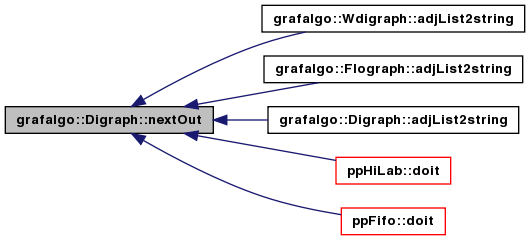
| void grafalgo::Digraph::rdag | ( | int | numv, |
| int | nume | ||
| ) |
Generate a random directed acyclic graph.
| numv | is the number of vertices on which the digraph is generated; if this object has n()>numv, the random graph is defined over the first numv vertices, leaving the remaining vertices with no edges |
| nume | is the number of edges in the generated digraph |
Definition at line 289 of file Digraph.cpp.
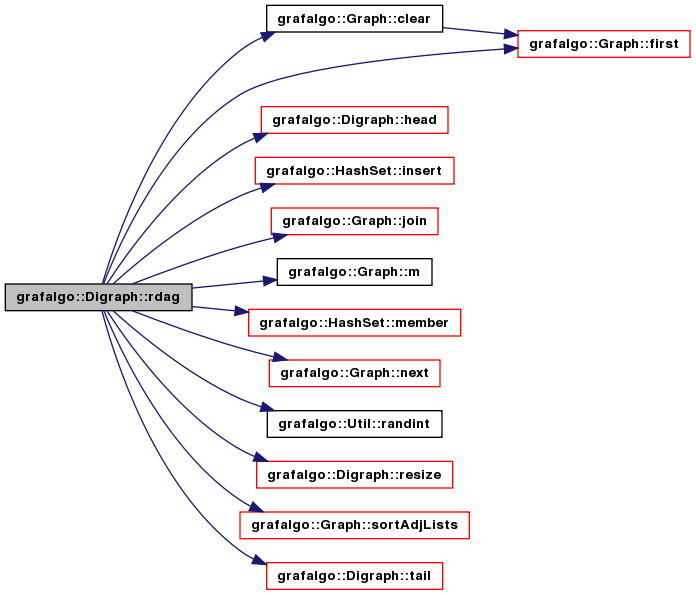
| bool grafalgo::Digraph::readAdjList | ( | istream & | in | ) | [protected, virtual] |
Read one edge from an input stream, add it to the graph.
| in | is an open input stream |
| in | is an open input stream |
Reimplemented from grafalgo::Graph.
Reimplemented in grafalgo::Flograph, grafalgo::Mflograph, grafalgo::Wdigraph, and grafalgo::Wflograph.
Definition at line 194 of file Digraph.cpp.
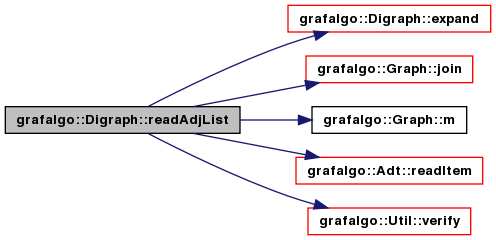
| bool grafalgo::Digraph::remove | ( | edge | e | ) |
Remove an edge from the Diraph.
| e | is the edge to be removed. |
Reimplemented from grafalgo::Graph.
Definition at line 101 of file Digraph.cpp.
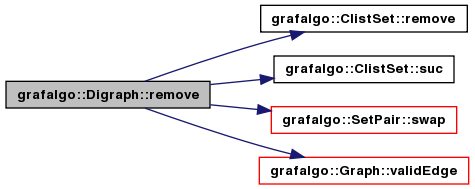
| void grafalgo::Digraph::resize | ( | int | numv, |
| int | maxe | ||
| ) | [virtual] |
Resize a Digraph object.
The old value is discarded.
| numv | is the number of vertices to allocate space for |
| maxe | is the number of edges to allocate space for |
Reimplemented from grafalgo::Graph.
Reimplemented in grafalgo::Flograph, grafalgo::Mflograph, grafalgo::Wdigraph, and grafalgo::Wflograph.
Definition at line 50 of file Digraph.cpp.


| void grafalgo::Digraph::rgraph | ( | int | numv, |
| int | nume | ||
| ) |
Read a graph.
| in | is an open input stream |
| numv | is the number of vertices on which the digraph is generated; if this object has n()>numv, the random graph is defined over the first numv vertices, leaving the remaining vertices with no edges |
| nume | is the number of edges in the generated digraph |
Reimplemented from grafalgo::Graph.
Definition at line 233 of file Digraph.cpp.
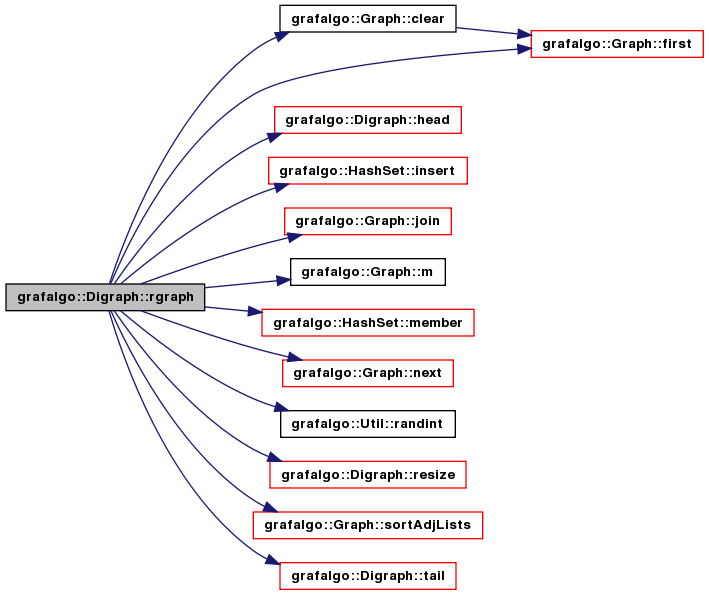
| edge grafalgo::Digraph::tail | ( | edge | e | ) | const [inline] |
| string & grafalgo::Digraph::toDotString | ( | string & | s | ) | const [virtual] |
Construct a string in dot file format representation of the Directed Graph object.
For small graphs (at most 26 vertices), vertices are represented in the string as lower case letters. For larger graphs, vertices are represented by integers.
| s | is a string object provided by the caller which is modified to provide a representation of the Graph. |
Reimplemented from grafalgo::Graph.
Reimplemented in grafalgo::Flograph, grafalgo::Mflograph, grafalgo::Wdigraph, and grafalgo::Wflograph.
Definition at line 152 of file Digraph.cpp.
